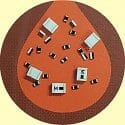source: AVX news
Qualified to AEC-Q200, the new, low-profile, 0402 & 0805 Accu-L Series inductors deliver ultra-tight inductance tolerances, in addition to: RF power capabilities, high Q, high SRF, low DC resistance, & outstanding high-frequency performance from 450-2,400MHz.
FOUNTAIN INN, S.C. (January 22, 2018) -AVX Corporation, a leading manufacturer and supplier of passive components, interconnects, sensors, and control solutions, has released a new series of thin film multilayer chip inductors especially designed to meet demanding performance specifications in automotive signal and power applications. Qualified to AEC-Q200, the new automotive grade Accu-L® Series inductors exhibit ultra-tight inductance tolerances down to ±0.05nH, in addition to: RF power capabilities, high Q, high self-resonant frequency (SRF), low DC resistance (Rdc), and outstanding high-frequency performance from 450MHz to 2,400MHz. Available in small, ruggedly constructed, low profile 0402 and 0805 chip sizes, the series also delivers exceptional intra-lot and lot-to-lot physical and electrical consistency that makes it ideal for use in automotive signal and power applications that require apex accuracy, including: matching networks and filters in vehicle-to-vehicle communications, infotainment, vehicle location, keyless entry, global positioning, and radar systems.
“Based on well-established thin film technology and materials, and named for the extreme accuracy they reliably deliver in demanding applications, our new AEC-Q200-qualified Accu-L Series inductors exhibit excellent performance characteristics in high-frequency automotive signal and power applications, as well as virtually eliminate the variances in dielectric quality, electrode conductivity, and physical size that are inherent to ceramic capacitor technologies,” said Larry Eisenberger, principal technical marketing engineer, AVX.
Rated for use in operating temperatures spanning -55°C to +125°C, automotive grade Accu-L inductors are currently available in 0402 and 0805 chip sizes with RoHS compliant and lead-free compatible nickel/solder-coated terminations. Inductance values for 0402 parts extend from 0.56nH to 6.8nH, inductance tolerances span ±0.05nH to ±0.5nH, and minimum SRF values range from 6,500MHz to 20,000MHz. Inductance values for 0805 parts extend from 1.2nH to 22nH, inductance tolerances span ±0.1nH to ±5%, and minimum SRF values range from 1,400MHz to 20,000MHz.
Compatible with both flexible and alumina circuit boards and automated reflow and hand soldering processes, automotive grade Accu-L Series inductors are packaged on tape and reel, and should be handled with plastic-tipped tweezers, vacuum pick-ups, or other pick-and-place machinery. Finished parts are tested for visual and mechanical characteristics and other electrical parameters. Each production lot is 100% tested for both DC resistance and inductance at 450MHz, as well as evaluated on a sample basis for: Q at test frequency, static humidity resistance, and endurance.































